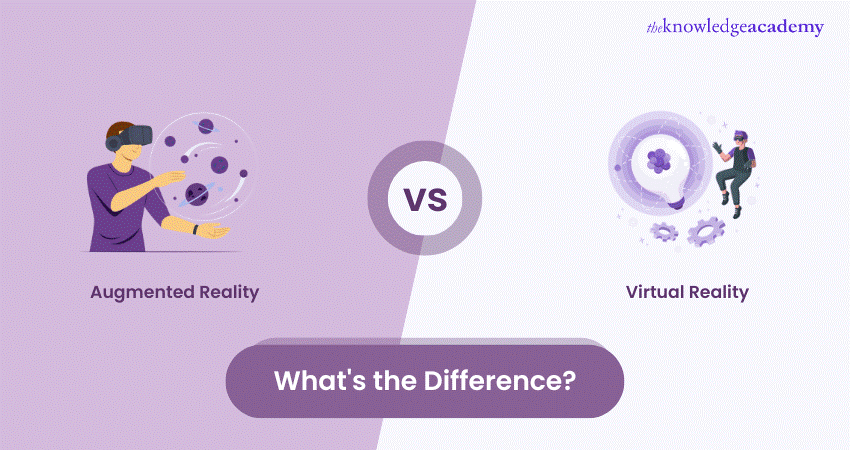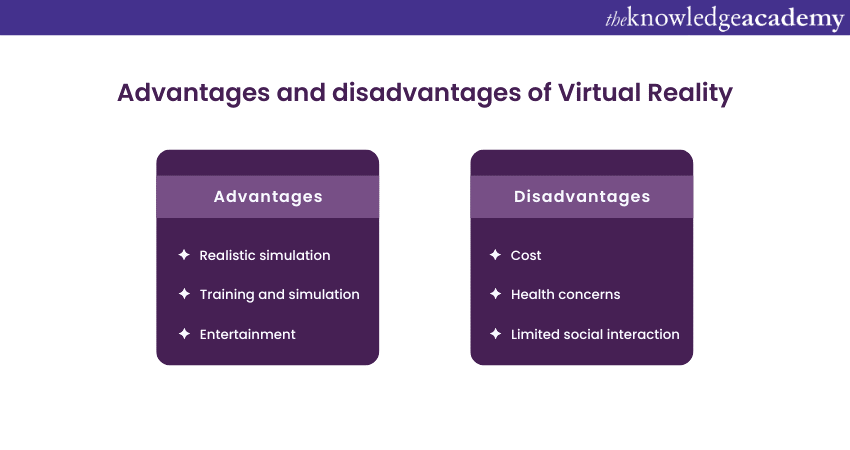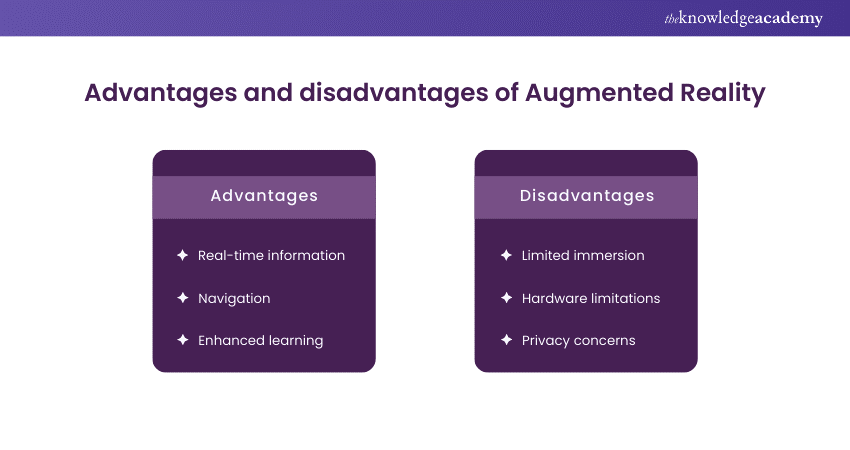We may not have the course you’re looking for. If you enquire or give us a call on +43 720 115337 and speak to our training experts, we may still be able to help with your training requirements.
Training Outcomes Within Your Budget!
We ensure quality, budget-alignment, and timely delivery by our expert instructors.

In today's era of rapid technological advancements, Augmented Reality (AR) and Virtual Reality (VR) have emerged as revolutionary forces. These technologies are reshaping the way we interact with the digital world. As the lines between the physical and virtual continue to smudge, it becomes imperative to understand the distinction between Augmented Reality vs Virtual Reality.
So, if you are a tech enthusiast seeking a deeper understanding of these cutting-edge technologies, this blog is for you. Explore this blog to learn about the distinction of Augmented Reality vs Virtual Reality. Also, explore their unique functionalities and their workings.
Table of Contents
1) Understanding Virtual Reality
2) What is Augmented Reality?
3) Difference between Augmented Reality vs Virtual Reality
4) How does AR work?
5) How does VR work?
6) How AR and VR work together?
7) Conclusion
Understanding Virtual Reality
Virtual Reality (VR), an advanced technology, immerses users in a computer-generated environment, creating a sense of presence and interaction. It often involves using specialised hardware, such as VR headsets and motion controllers, to simulate a realistic and interactive experience. VR applications extend across various industries, from entertainment and gaming to healthcare, education, and training.
Advantages and disadvantages of Virtual Reality
The following are the advantages of Virtual Reality:

a) Realistic simulation: VR provides unparalleled realism, enabling users to feel as if they are physically present in a simulated environment.
b) Training and simulation: Industries leverage VR for immersive training simulations. They allow professionals to practice and enhance their skills in a risk-free virtual setting.
c) Entertainment: VR revolutionises gaming experiences by offering immersive and interactive gameplay, providing users with more engaging entertainment.
The following are the disadvantages of Virtual Reality:
a) Cost: The initial investment in VR equipment, including high-quality headsets and compatible devices, can be prohibitive for some individuals and organisations.
b) Health concerns: Prolonged use of VR may lead to motion sickness or discomfort for specific users. This can impact the widespread adoption of the technology.
c) Limited social interaction: VR experiences are often solitary, lacking the social aspects found in traditional forms of entertainment.
Explore cutting-edge technologies with our Advanced Technologies Courses for a future-ready skill set – join today!
What is Augmented Reality?
Augmented Reality (AR) enhances the real-world environment by overlaying digital information, graphics, or objects onto the user's surroundings. AR applications can be experienced through numerous devices like smartphones, smart glasses, or heads-up displays. Unlike VR, AR does not replace reality but supplements it with additional information or interactive elements.
Advantages and disadvantages of Augmented Reality
The following are the advantages of Augmented Reality:

a) Real-time information: AR provides users with contextual and real-time information, enhancing their understanding of the environment.
b) Navigation: AR applications can offer interactive navigation assistance, such as overlaying directions or points of interest onto the user's field of view.
c) Enhanced learning: AR provides students with interactive and visual learning experiences in education, making complex subjects more accessible.
The following are the disadvantages of Augmented Reality:
a) Limited immersion: AR enhances reality but does not provide the same level of immersion as VR, which might be a drawback in specific applications.
b) Hardware limitations: The effectiveness of AR depends on the capabilities of the device's camera, sensors, and processing power, which may limit its functionality.
c) Privacy concerns: As AR integrates digital content into the real world, privacy and data security concerns may arise, especially when using AR in public spaces.
Explore the future of technology with our Introduction to Virtualisation Technologies Course - join now for hands-on expertise!
Difference between Augmented Reality vs Virtual Reality
The fundamental distinction lies in the level of immersion. VR entirely replaces the real world with a simulated one, creating a fully immersive experience. On the contrary, AR enhances the real world by overlaying digital content, allowing users to interact with virtual and real elements simultaneously.
The key distinction in terms of immersion lies in the extent to which users are separated from the real world. VR achieves a high level of immersion by completely replacing the real-world visuals and sounds with virtual ones. Users wearing VR headsets feel as though they have entered an alternate reality, disconnected from their physical surroundings.
In contrast, AR maintains a connection to the real world, with digital content seamlessly integrated into the user's field of view. This allows users to engage with both the virtual and real elements concurrently. Refer to the table give below to learn more about the differences between Virtual and Augmented Reality:
|
Feature |
Augmented Reality (AR) |
Virtual Reality (VR) |
|
Interaction with reality |
Overlays digital content on the real world |
Creates a completely immersive virtual environment |
|
Environment |
Enhances the existing environment |
Simulates a computer-generated environment |
|
Devices |
Smartphones, AR glasses, heads-up displays |
VR headsets, VR glasses, VR rooms |
|
Level of immersion |
Partial immersion in the real world |
Complete immersion in a virtual environment |
|
Applications |
Navigation, gaming, education, retail |
Gaming, simulations, training, virtual experiences |
|
Examples |
Pokémon Go, Snapchat filters, Google Maps AR |
Oculus Rift, HTC Vive, PlayStation VR |
|
Use in industries |
Retail, healthcare, education, manufacturing |
Gaming, healthcare, military, architecture |
|
Real-world interaction |
Allows users to interact with both real and digital elements |
Isolates users from the real world for immersive experiences |
|
Dependency on hardware |
Less hardware-intensive, often relies on existing devices |
Requires specialised VR headsets and equipment |
|
Social interaction |
Can support social interactions in the real world |
Typically isolates users from physical surroundings |
|
Cost |
Generally more affordable due to diverse device options |
VR headsets can be more expensive |
How does AR work?
AR uses sensors, cameras, and algorithms to recognise and interpret the real-world environment. The device captures information about the surroundings, and the software then superimposes digital content onto the user's view, aligning it with the physical environment. AR can be experienced through smartphones, tablets, smart glasses, or heads-up displays.
How does VR work?
VR creates a simulated environment by presenting users with computer-generated visuals and, in some cases, sounds. Specialised VR headsets track the user's movements and adjust the display accordingly, creating a sense of presence in the virtual world. Users can connect with the virtual environment by using controllers or other input devices.
How AR and VR work together?
AR and VR can culminate into a concept known as Mixed Reality (MR), where virtual and real elements coexist in the same space. This integration aids users to interact with both virtual and real-world objects simultaneously.
For example, AR might be used to overlay digital information onto physical objects within a VR environment, offering a more interactive and dynamic experience. The combination of AR and VR technologies opens new possibilities for applications in various fields, including gaming, education, design, and collaborative work environments.
Transform your expertise in Virtual Reality with our comprehensive Virtual Reality (VR) Training - sign up now!
Conclusion
We hope you have understood the difference between Augmented Reality vs Virtual Reality through our blog! The advancements in both VR and AR technologies are accelerating swiftly. With ongoing technological progress, it promises to be intriguing to witness the diverse applications these technologies will find in both professional settings and everyday activities.
Frequently Asked Questions

Augmented Reality (AR) and Virtual Reality (VR) represent distinct approaches to immersive technology. AR enriches the real-world environment by overlaying digital content, allowing users to see and connect with computer-generated elements alongside physical objects. It enhances tasks like navigation, maintenance, and education. On the contrary, VR creates a complete, computer-generated environment that isolates users from the real world. This immersive experience is commonly used in gaming, simulations, and training scenarios, where users are transported to entirely virtual realms.

Indeed, Augmented Reality (AR) finds widespread applications in industries where enhancing real-world tasks with digital information is crucial. Healthcare utilises AR for surgeries and medical training, while maintenance and repair industries benefit from AR's ability to provide real-time instructions. On the other hand, Virtual Reality (VR) is often preferred in gaming for its immersive experiences, as well as in simulation-based training for professions like aviation and healthcare.

The Knowledge Academy takes global learning to new heights, offering over 30,000 online courses across 490+ locations in 220 countries. This expansive reach ensures accessibility and convenience for learners worldwide.
Alongside our diverse Online Course Catalogue, encompassing 17 major categories, we go the extra mile by providing a plethora of free educational Online Resources like News updates, blogs, videos, webinars, and interview questions. Tailoring learning experiences further, professionals can maximise value with customisable Course Bundles of TKA.

The Knowledge Academy’s Knowledge Pass, a prepaid voucher, adds another layer of flexibility, allowing course bookings over a 12-month period. Join us on a journey where education knows no bounds.

The Knowledge Academy offers various Advanced Technologies Courses, including Introduction To Virtualisation Technologies, Internet Of Things IoT Systems And Applications Training etc. These courses cater to different skill levels, providing comprehensive insights into What is the Metaverse?
Our Advanced Technology blogs covers a range of topics related to Virtual Reality, offering valuable resources, best practices, and industry insights. Whether you are a beginner or looking to advance your Advanced Technology skills, The Knowledge Academy's diverse courses and informative blogs have you covered.







 Top Rated Course
Top Rated Course




 If you wish to make any changes to your course, please
If you wish to make any changes to your course, please


